How to Decorate Living Room: A Fun, Real-Life Guide to Styling Your Space
So, you’re standing in your living room, sipping your coffee, and asking yourself: “Why does this place look like I borrowed it from a college rental brochure?” Don’t panic. Decorating a living room doesn’t have to feel like rocket science. With a few smart choices, a little creativity, and maybe a sprinkle of sarcasm (because who wants boring?), you can transform your space into a stylish, cozy, personality-filled hub that makes you proud to flop on the couch after a long day.
This is your no-nonsense, real-life guide to how to decorate living room spaces so they actually feel like you. No “perfect Instagram home” pressure. No expensive designer nonsense. Just practical tips, personal touches, and ideas you can steal right away.
Step 1 — Start With Your Vibe
Before you even think about buying throw pillows or paint swatches, let’s talk vibe. Your living room should match the mood you want to feel every time you walk in. Otherwise, you’ll end up with random furniture that looks more “flea market clearance” than “intentional design.”
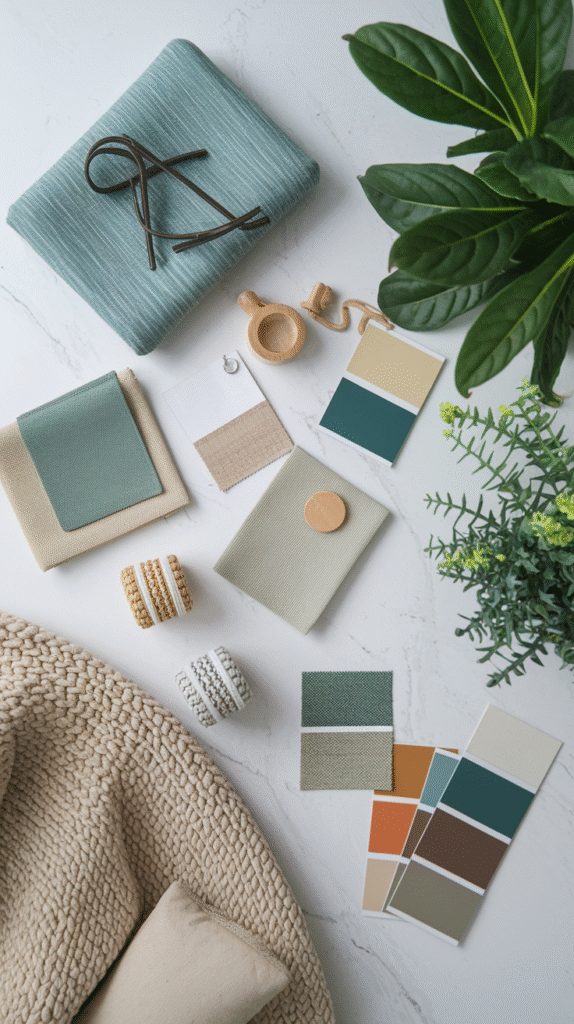
So, how do you decide your vibe? Ask yourself: Do I want my living room to scream cozy hangout, minimalist chic, bold and artsy, or maybe farmhouse rustic?
Some popular vibes:
- Cozy & relaxed — warm tones, soft fabrics, dim lighting, chunky throws.
- Bold & modern — clean lines, pops of bright color, geometric art.
- Natural & airy — neutral palette, houseplants everywhere, light fabrics.
- Eclectic & fun — mix of styles, quirky decor, conversation pieces.
- Farmhouse & rustic — wood accents, natural textures, vintage charm.
IMO, picking your vibe early makes everything easier. Otherwise, you’ll find yourself arguing in IKEA over whether the neon-pink lamp “works” with your leather sofa (spoiler: it probably doesn’t).
Step 2 — Figure Out Your Layout
Once you’ve nailed down your vibe, you need a layout that doesn’t feel like an obstacle course. You could have the prettiest furniture in the world, but if you trip over a coffee table every time you sit down, your living room is doomed.
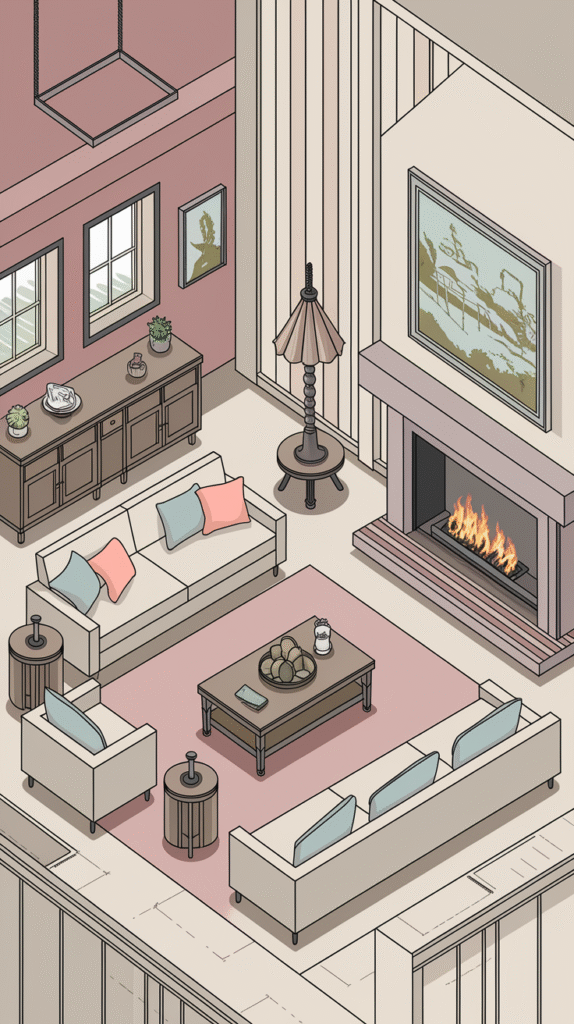
Golden rules of layout:
- Traffic flow matters — keep pathways clear so people aren’t bumping into furniture every five seconds.
- Pick a focal point — fireplace, TV, big window, or statement wall. Arrange seating around it.
- Create conversation zones — angle sofas and chairs toward each other instead of lining them up like a dentist’s waiting room.
- Think scale — don’t squeeze a massive sectional into a tiny apartment. Similarly, don’t put a tiny loveseat in a big room—it’ll look lonely.
Here’s a trick: grab painter’s tape and map out where furniture would go on the floor. It’s way easier than trying to drag a 200-pound couch across the room (trust me, my back still remembers that mistake).
Step 3 — Choose the Right Sofa
The sofa is the king of the living room. Seriously, it takes up the most space, gets the most use, and sets the whole tone. Picking the wrong sofa is like wearing shoes that don’t fit—nothing else feels right.
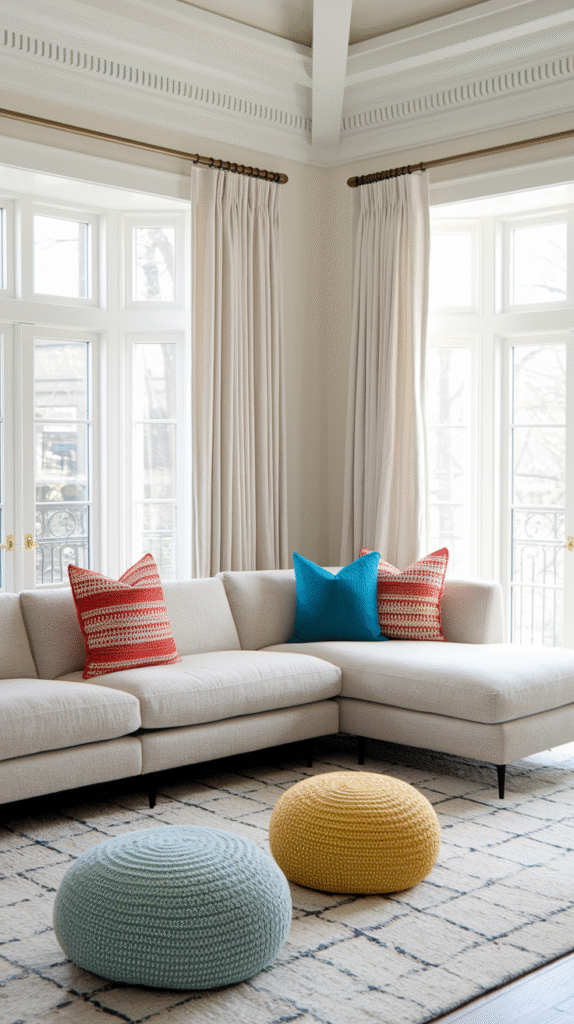
Things to consider:
- Size: Measure your space (twice!) before buying. Don’t eyeball it—your future self will thank you.
- Style: Sectionals = movie marathons. Sofa + chairs = flexible for entertaining.
- Fabric:
- Leather = sleek and durable, but cold at first touch.
- Velvet = luxe, but shows every crumb.
- Linen blends = casual, breathable, forgiving.
- Performance fabrics = a lifesaver if you have kids or pets.
- Color: A neutral sofa with colorful pillows gives you flexibility.
And please, make sure it fits through your door. Once, I had a gorgeous sofa delivered only to find it couldn’t make it past the stairwell. Returning it was a whole comedy sketch I’d rather not relive.
Step 4 — Layer in Textures
Ever walked into a living room that felt flat? Nine times out of ten, it’s missing textures. Texture is what makes a space feel alive and cozy—it’s the difference between “meh” and “wow, this feels good.”
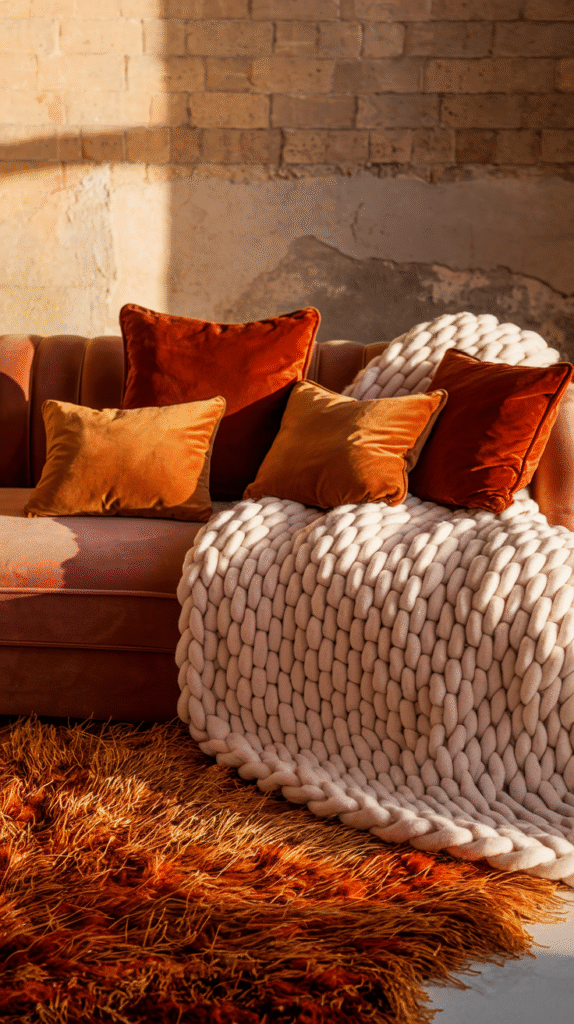
Some easy wins:
- Soft fabrics — throw blankets, rugs, pillows.
- Natural materials — wood coffee tables, stone accents, wicker baskets.
- Smooth finishes — glass, mirrors, metal.
Mixing opposites creates balance. A leather sofa feels luxe, but toss on a chunky knit blanket and suddenly it’s inviting. Without texture, your living room looks like Batman’s hideout: cool, but a little depressing.
Step 5 — Pick a Color Palette
Colors set the mood instantly. A bright yellow wall feels energetic, while a soft gray whispers relaxation. And no, you don’t have to repaint everything—pillows, rugs, and art can define your palette too.
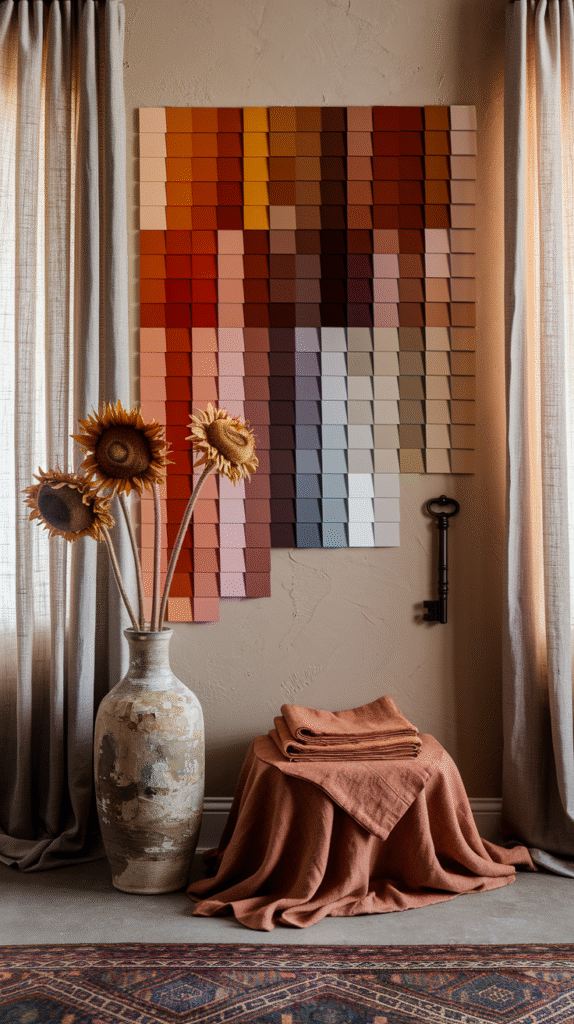
Popular palettes to steal:
- Neutrals + bold accent — timeless, flexible.
- Earthy tones (olive, rust, terracotta) — cozy, trendy, grounded.
- Black, white, and gold — chic and dramatic.
- Soft pastels — calming, fresh, perfect for smaller rooms.
Pro tip: Use the 60-30-10 rule: 60% main color, 30% secondary color, 10% accent. It keeps things balanced without feeling overwhelming.
Step 6 — Lighting Is Everything
Bad lighting can ruin a good room faster than an ugly couch. You don’t want “hospital exam room” vibes in your living room, right?
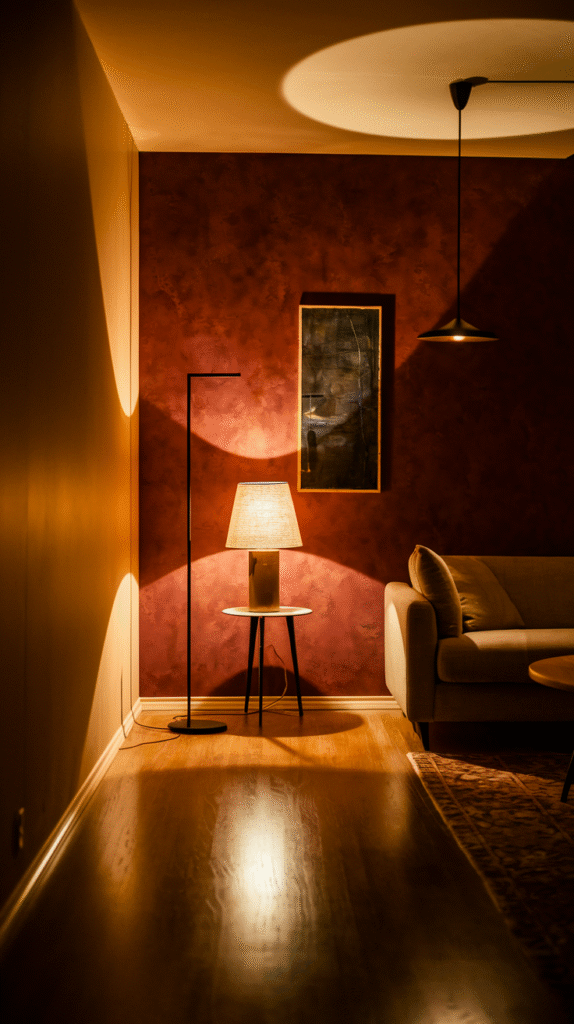
Aim for three layers of light:
- Ambient lighting — ceiling fixtures, chandeliers, overheads.
- Task lighting — reading lamps, desk lamps.
- Accent lighting — candles, LED strips, wall sconces.
Want a hack? Swap out your bulbs for warm light and add a dimmer switch. Boom—your living room just went from “boring meeting space” to “cozy Netflix cave.”
Step 7 — Add Rugs That Define the Space
A rug is like eyeliner—it pulls the whole look together. Without one, your furniture feels like it’s floating in space.
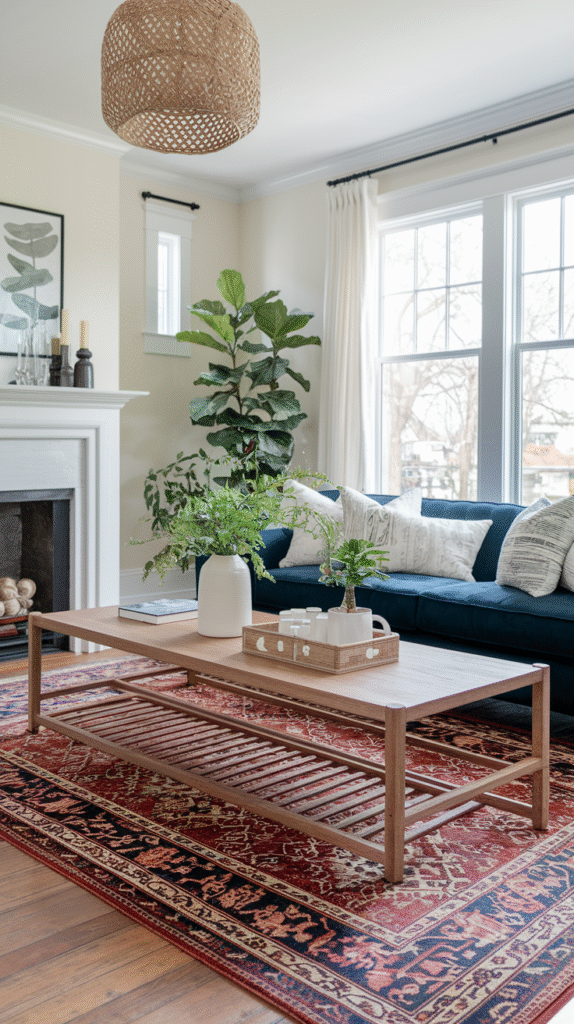
Rug rules that actually matter:
- The front legs of your sofa and chairs should sit on the rug.
- Bigger is better—tiny rugs make the room feel awkward.
- In large spaces, layer rugs (like a big jute rug with a patterned one on top).
And don’t forget about materials: wool rugs are durable, cotton is casual, jute is earthy, and synthetics are budget-friendly.
Step 8 — Don’t Forget the Walls
Bare walls feel like unfinished homework. Decorating them instantly makes your living room feel complete.
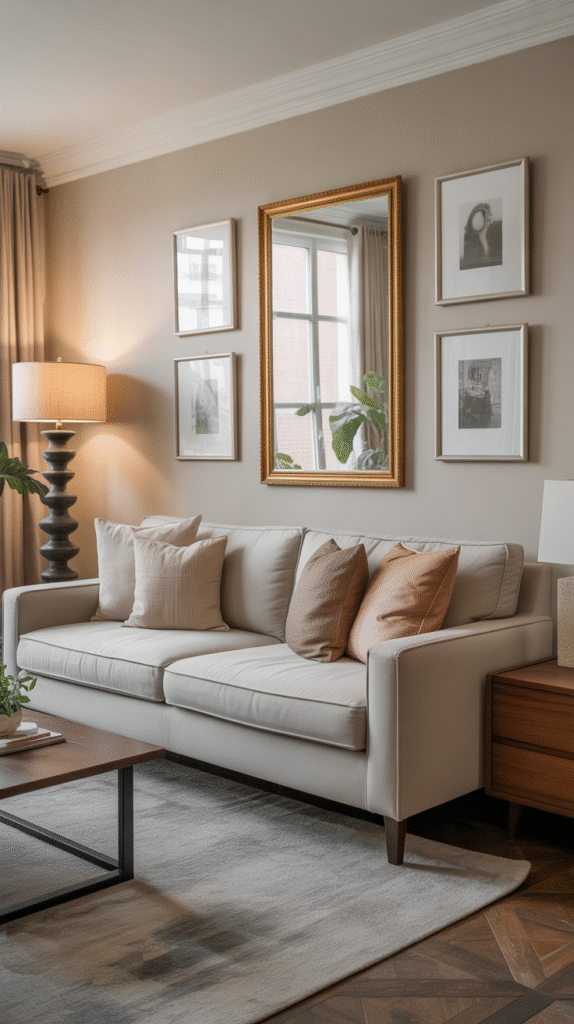
Ideas to try:
- Gallery wall — mix photos, art, and prints in different frames.
- Oversized art — one bold piece makes a statement.
- Mirrors — bounce light and make rooms feel bigger.
- Shelving — display books, plants, or your prized Funko Pop collection (I won’t judge).
Just remember: hang art at eye level. Unless you’re 7 feet tall, keep it around 57–60 inches from the floor.
Step 9 — Bring in Greenery
Plants are the easiest way to add life—literally. They soften corners, add color, and clean the air.
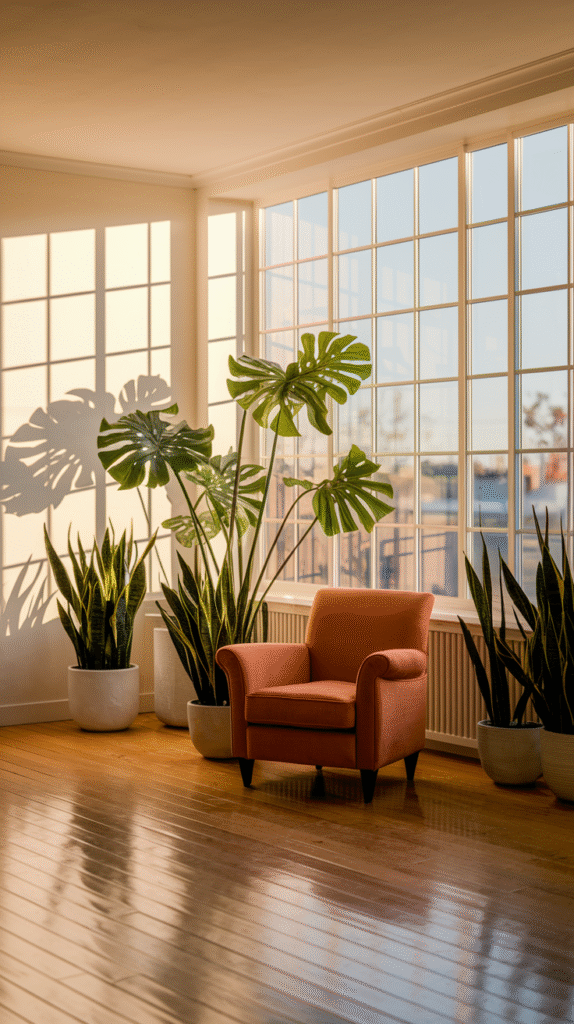
Some foolproof picks:
- Snake plant (basically immortal).
- Pothos (grows like crazy).
- Monstera (the Instagram plant).
- Fiddle-leaf fig (dramatic but needy).
Not a plant person? Fake it with high-quality faux plants. Nobody has to know, and you’ll never feel guilty about forgetting to water.
Step 10 — Accessorize Without Clutter
Accessories make your space feel personal, but overdo it and you’ll end up with clutter central.
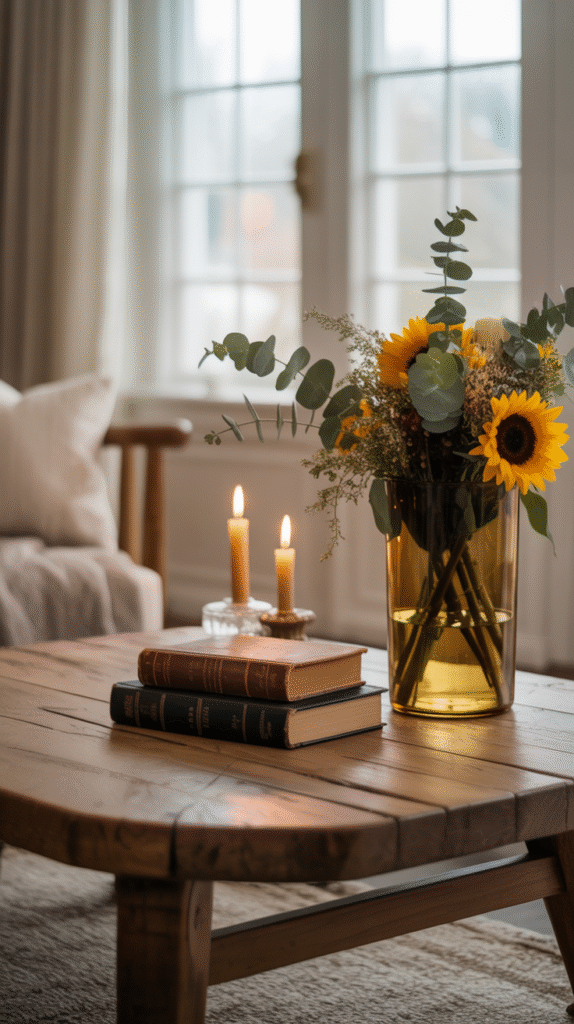
Stick with these basics:
- Coffee table books.
- Stylish vases.
- Candles (bonus: they make your place smell amazing).
- Decorative bowls or trays to corral remotes.
The trick? Group items in threes, vary heights, and always leave some breathing room. Negative space is your friend.
Step 11 — Personalize It
A living room should feel like yours, not a furniture showroom.
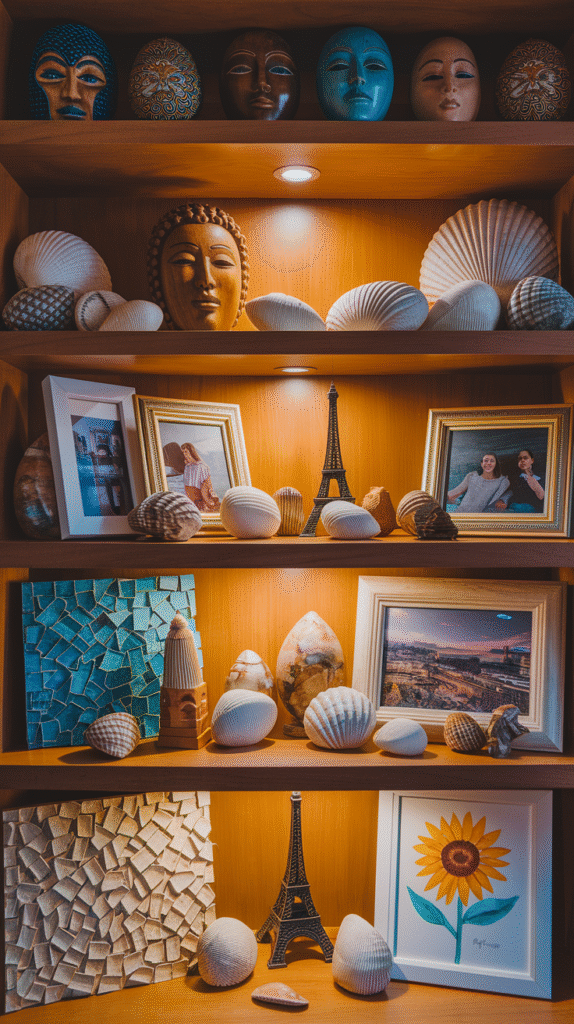
Ways to personalize:
- Display travel souvenirs.
- Frame meaningful photos.
- Hang DIY art (even if it’s just a canvas you painted one night with friends).
- Add quirky touches like a neon sign or vintage record player.
When people walk in, they should say, “This feels like you,” not “Is this a Pottery Barn ad?”
Step 12 — Keep It Flexible
Life changes—new roommates, kids, pets, trends. Your living room should keep up.
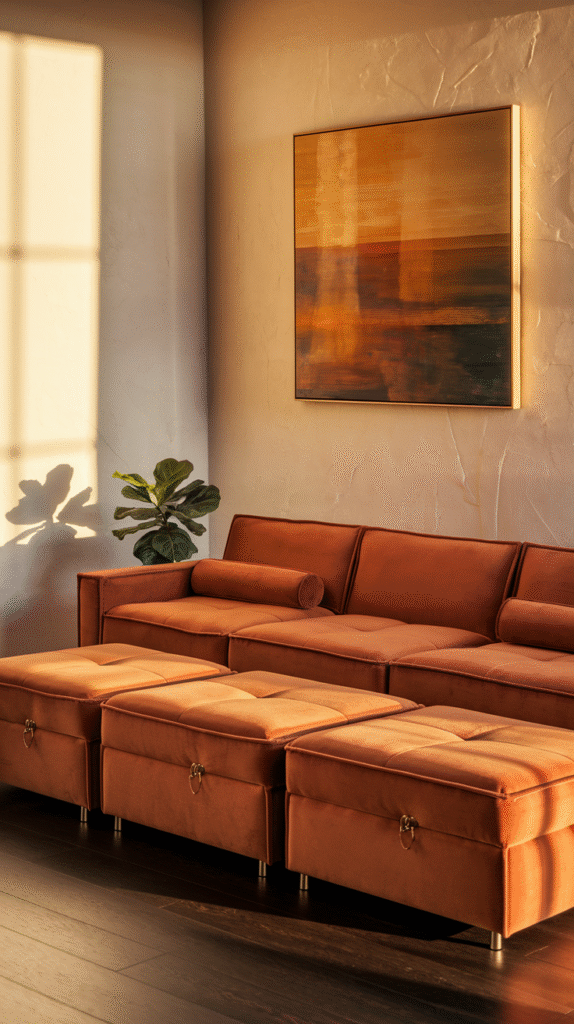
- Modular furniture — rearrange as needed.
- Slipcovers — refresh your sofa without buying new.
- Storage ottomans — seating + clutter control.
- Floating shelves — easy to move or swap decor.
Think of your living room as a living, breathing thing that evolves with you.
Style-Specific Inspirations
Want examples? Here’s how these tips translate to different styles:
- Modern minimalist — neutral sofa, black accents, sleek lighting.
- Boho chic — layered rugs, plants galore, rattan chairs, colorful pillows.
- Farmhouse — shiplap walls, wood beams, cozy plaid throws.
- Industrial loft — exposed brick, leather sofa, metal accents.
- Scandi cozy — white walls, light wood, wool textures, soft pastels.
Common Mistakes to Avoid
Because sometimes it’s easier to learn from what not to do.
- Buying everything at once → you’ll regret half of it.
- Pushing all furniture against the walls → makes the room feel cold.
- Ignoring lighting → even the best furniture looks bad in bad light.
- Skipping rugs → your room will look unfinished.
- Over-decorating → clutter kills style.
Final Thoughts
Decorating your living room isn’t about perfection—it’s about creating a space you actually want to live in. Focus on your vibe, your layout, and a few smart choices, then layer in personal touches that feel like home.
Start small. Rearrange what you already own, add a cozy throw, or swap your lighting. Before you know it, your living room will go from “meh” to “wow, this feels like me.” And honestly, that’s the only design goal that matters.
So grab that blanket, light a candle, and start experimenting. Who knows—you might even end up loving your living room more than your bed (but hey, no promises 😉).
